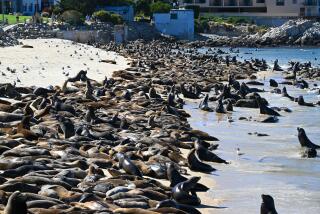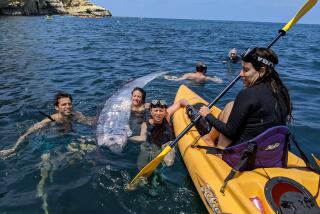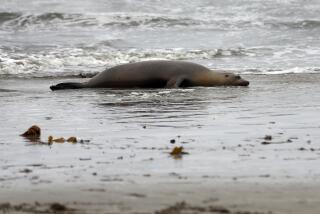Watch thousands of tiny red crabs invade Channel Islands

Pelagic red crabs usually found in Mexico appear off the coast of the Channel Islands.
Researchers may have found another telltale sign that the strengthening El Niño will be Godzilla-like.
On an Aug. 15 trip, sea lion biologist Jeff Harris filmed tens of thousands of tiny red crabs in the ocean at Point Bennett off San Miguel Island in Santa Barbara County. As he sat in a raft and paddled through the warm water, Harris shot video of the creatures bobbing in kelp and interacting with a northern fur seal.
More surprising, however, was that these types of crustaceans, pelagic red crabs or pleuroncodes planipes, are usually found in Mexico’s warm waters, said Harris, who works for the National Marine Mammal Laboratory.
But as the sea temperatures increase, the crabs will follow the pockets of warm water and move north.
“They will do all right until they hit cold water and then they will strand on the beaches,” he said. “This is definitely associated with El Niño.”
That explains why millions of these tiny crabs have been recently washing ashore miles of coastline from Orange to San Diego counties, attracting hundreds of onlookers, he said.
Once the ocean water sweeps these critters to shore, they die.
While researching sea lions for two months on the island, one of the eight Channel Islands, he noticed the crabs were marooning more than once a week.
“This is very important because the water is already very warm and it is said that the El Niño is still on its way,” Harris said. “This could be a record event.”
It’s also bad news for California sea lions and northern fur seals.
Pups are starving in the Channel Islands as their mothers find it difficult to find food in the unusually warm water in the Pacific ocean, according to the National Oceanic and Atmospheric Administration.
Their food staples, including sardines and anchovies, have moved away from the warm water, going north in search of cooler water.
This leaves the pups frail, emaciated and exhausted, leaving them stranded along the California coast.
During El Niño, the tiny crabs are occasionally found in the sea lion diet, Harris said. But the crabs are not a staple for the animals in the Channel Islands. California sea lions don’t consume crabs.
“I think they might not offer much nutritional value, or it is just that they are unaccustomed to foraging on a crustacean,” he said.
The National Weather Service’s Climate Prediction Center said computer models are predicting a strong El Niño to peak in the late fall or early winter. At this time, this year’s El Niño appears to be stronger than it was at this time of year in 1997, when the most powerful El Niño on record formed.
For breaking news in California, follow @VeronicaRochaLA on Twitter.
More to Read
Sign up for Essential California
The most important California stories and recommendations in your inbox every morning.
You may occasionally receive promotional content from the Los Angeles Times.










